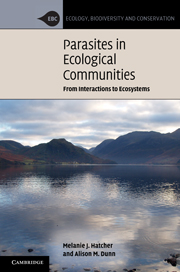Book contents
- Frontmatter
- Contents
- Acknowledgements
- List of abbreviations
- 1 Introduction
- 2 Parasites and competitors
- 3 Parasites and predators
- 4 Parasites and intraguild predation
- 5 Plant pathogens and parasitic plants
- 6 Parasites and invasions
- 7 Ecosystem parasitology
- 8 Emerging diseases in humans and wildlife
- 9 Where do we go from here?
- References
- Index
6 - Parasites and invasions
Published online by Cambridge University Press: 05 August 2012
- Frontmatter
- Contents
- Acknowledgements
- List of abbreviations
- 1 Introduction
- 2 Parasites and competitors
- 3 Parasites and predators
- 4 Parasites and intraguild predation
- 5 Plant pathogens and parasitic plants
- 6 Parasites and invasions
- 7 Ecosystem parasitology
- 8 Emerging diseases in humans and wildlife
- 9 Where do we go from here?
- References
- Index
Summary
Introduction
Biological invasions are widespread in natural and managed habitats, where they may drive changes in biodiversity and community structure, and are frequently of great economic importance (Mack et al., 2000; Pimentel et al., 2000; Lockwood et al., 2007; McGeoch et al., 2010). Understanding the mechanisms that underpin invasions is essential in predicting and managing invasion outcomes. There is growing evidence that parasites can modify the success of an invasion and its impact on the community. Furthermore, the study of biological invasions provides examples of ongoing, natural experiments in which to observe the effect of parasites on novel hosts and the impact of parasites on the wider community (Prenter et al., 2004; Dunn, 2009).
A biological invasion can be defined as the spread of a non-indigenous species from the point of introduction to some substantial level of abundance (Elton, 1958). When the invasive species is a parasite, or host to a parasite introduced with it, the novel host–pathogen interactions may sometimes also result in emerging infectious diseases (EIDs) (Chapter 8). These can include the spatial range expansion of a parasite within existing host species (e.g. the spread of malaria linked to climate change – discussed in Chapter 8), or a species range expansion to a new host species (such as spread of squirrel pox virus from grey squirrels to red squirrels – discussed in Section 2.6.1).
- Type
- Chapter
- Information
- Parasites in Ecological CommunitiesFrom Interactions to Ecosystems, pp. 224 - 264Publisher: Cambridge University PressPrint publication year: 2011
- 1
- Cited by

